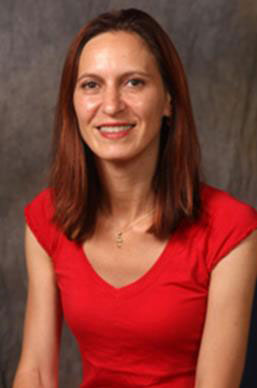Learn about Dr. Brumariu's clinical experience and research in developmental psychopathology.
 By Lauren Knopf, M.A.
By Lauren Knopf, M.A.
Dr. Brumariu joined the Derner community as an assistant professor in the fall of 2013. A graduate of Kent State University, Dr. Brumariu completed clinical and research postdoctoral fellowships at Harvard Medical School from 2012-2013. She brings to Derner a wealth of clinical experience with children, families, and couples, as well as extensive research in developmental psychopathology.
LK: What appealed to you about teaching and working at Derner?
LB: When I visited, I got a sense of Derner’s strong commitment to training, and I was impressed by the quality of students’ work and the variety of clinical and research interests represented by students and faculty. I find mentoring students very rewarding, so the opportunity to work with students at various levels – undergraduate, Master’s, and PhD – was very appealing to me. Also, it seemed like a fun department. And I was right about that. I enjoy it here.
LK: Your enthusiasm for working with children and families, as well as for developmental research, is evident. How do you strike a balance between clinical work and research?
LB: I do not conceptualize them as competing interests, but rather as naturally integrated and complementary. My formal training is in clinical child psychology, and my mentors from graduate school and postdoctoral studies are psychologists with developmental training. If someone asks me how I define myself, I say that I’m a developmental psychopathologist. That’s how I put all the pieces together.
LK: How did you start your career path in psychology?
LB: In Romania, where I grew up, you choose a career track in high school and attend a school with a specialized curriculum. My high school prepared graduates to be elementary school teachers, up to grade five, and students who decided to pursue a college education were well prepared for college entrance examinations in pedagogy and psychology, or law. I trained in high school to be an elementary school teacher, then I decided to apply for college with a specialization in psychology. In my first year of college, I had two experiences that led me into child psychology. I met a clinical psychologist who gave me a unique introduction to the field by allowing me to shadow her, then later to see cases under supervision. Then I met a group of students who were in the process of developing schools within hospitals for hospitalized children – the first school system of its kind in Romania. This gave me the opportunity to be involved in developing a hospital school, primarily for children with chronic renal illnesses or cancer diagnoses. After college, I continued to work in the hospital as a psychologist, while also working as a school psychologist. So, really, I never thought about doing anything else.
LK: Much developmental research and associated interventions are focused on infancy or adolescence, while your research has examined the often neglected “middle childhood” years. What is unique about this developmental period and why is it important to investigate?
LB: What I find appealing about developmental research is its relevance and applicability to every aspect of psychology. It covers the lifespan, from attachment in infancy, to development of peer relationships and romantic relationships; it informs our understanding of normative development and psychopathology. Each developmental period is unique in its own way. I am particularly interested in middle childhood, roughly ages 7 to 12, because the significant changes that take place during this period create unique demands and opportunities for growth. The child’s social world expands, peers become more important, schooling makes greater demands – children are more independent from parents, but not completely independent. From an attachment perspective, this is a very neglected period of time. There are many conceptual pieces not yet fully explored. How does attachment look at this age, behaviorally? We have a clear picture of attachment behavior in infancy and adulthood, but there is no gold standard for measuring attachment in middle childhood.
Another direction is testing comprehensive models including additional factors that may mediate or explain the links between attachment and clinical symptoms or adaptation. Further, there are also findings in neuroscience, which elaborate and expand on the neural components of attachment related systems such as the caregiving system. I predict this will be an area that will be developed significantly in the next ten years.
LK: You’ve already made an impact on the Derner curriculum by helping to propose a new Child and Family concentration in the doctoral program. What is your vision for this training?
LB: I am excited about this new concentration, which was the result of collaboration among all faculty members. Our hope is that by providing doctoral level training in child and family psychology, Derner students will be prepared to deliver clinical services to children and families in a variety of settings, from hospitals to community clinics, and that these experiences will enhance their competitiveness for internship and on the job market.
For further information, please contact:
Todd Wilson
Strategic Communications Director
p – 516.237.8634
e – twilson@adelphi.edu